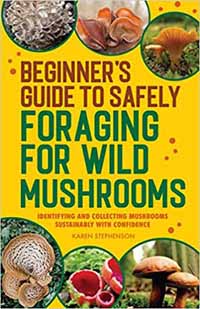

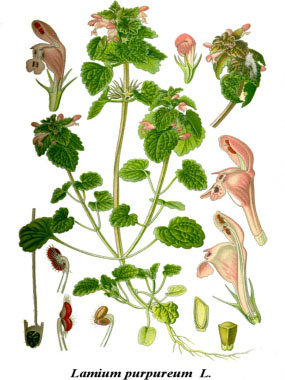
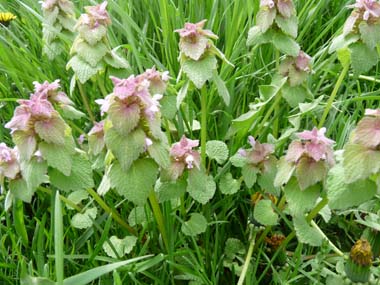
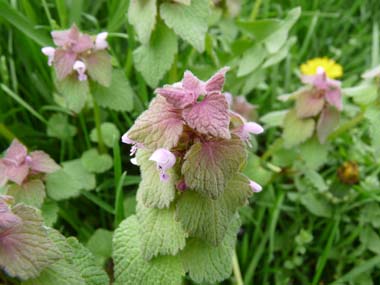
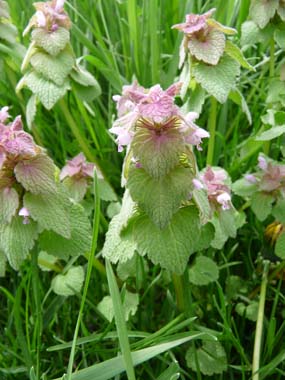
To support our efforts please browse our store (books with health benefits, etc.).
One of the first wild edible greens to appear in mid-winter, the purple deadnettle offers early forage for bees and for us. Native to many locations throughout Europe and Asia, this plant has naturalized in the U.S. and Canada. It can also be found in some locations in South America, Africa, Australia, and New Zealand. Purple deadnettle’s scientific name, Lamium purpureum, is in part from Latin, labium, meaning lip; and from Greek, Laimos referring to the throat or gullet. The Greek translation means ‘the devouring purple monster’. This plant has multiple health benefits, and is considered a diuretic, diaphoretic, astringent, purgative, and styptic. Purple deadnettle is in the Lamiaceae (mint) family. Though superficially similar to species of Urtica (true nettles) in appearance, it is not related and does not sting, hence the name "dead-nettle".
Distinguishing Features
Being in the mint family, a distinguishing feature is its four-sided square stem and leaves that grow opposite to one another. It has dark green to purplish ovate leaves with crenate margins (margins with rounded edges). Upper, small-stalked leaves are purplish to lilac, sometimes maroon and they angle downward to the ground. Leaves that are more purple means a phosphorus deficiency in the soil but are still safe to eat. This sprawling winter annual has stems that root at the nodes. Purple nettle is closely related to henbit which is also an edible plant.
Flowers
Purple deadnettle has distinctive purplish flowers which will typically bloom in April, and they last for about six weeks. Depending on the geographic location, this plant can bloom any time throughout the year. Three to six flowers occur per leaf pair. Tubular-shaped flowers have a 1.3 to 1.8 cm long, (0.5 to 0.7”) fused, petals that sometimes are hidden from view by leaf pairs. The flowers have a top hooded petal with 2 lower lip petals.
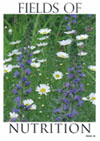 Fields
of Nutrition has medicinal benefits and vitamin/mineral content of Purple Deadnettle.
Fields
of Nutrition has medicinal benefits and vitamin/mineral content of Purple Deadnettle.
Leaves
Crowded ovate to heart-shaped leaves tend to overlap while angling downwards. Upper leaves are often purplish (sometimes reddish or maroon) with greenish undersides and are slightly hairy. Leaves have short petioles. Margins are crenate (roundish or scalloped). The leaves tend to grow abundantly around the stem’s axis.
Height
This plant can grow as high as 50 cm (20”) tall under the perfect conditions although they can be quite short as well. Stems are hairless to lightly hairy, streaked purple, and they are hollow.
Habitat
Purple deadnettle tends to grow in lawns, gardens, and in moist fallow fields. It also can be found along weedy edges of woodlands, along roadsides and various types of waste ground. Despite this plants ability to spread quickly, it is commonly cultivated as a ground cover. Purple deadnettle prefers full sun to light shade and moist fertile soil.
Edible Parts
The best time to harvest this plant is in spring. Harvest the top 5 to 10 cm (2 to 4”) of the flowering plant for use as a tea, in salads, smoothies, and to use in a variety of recipes.
Other Name
Red Deadnettle.
Similar Plants
Henbit, White Deadnettle.
Recipes
Winter Survival Food Handbook

PDF Plant Magazines
Types of Wild Food
Geographic Zones Seasons
Disclaimer
EdibleWildFood.com is informational in nature. While we strive to be 100% accurate, it is solely up to the reader to ensure proper plant identification. Some wild plants are poisonous or can have serious adverse health effects.
We are not health professionals, medical doctors, nor are we nutritionists. It is up to the reader to verify nutritional information and health benefits with qualified professionals for all edible plants listed in this web site. Please click here for more information.
Why Edible Wild Food?
- Food costs are rising
- Free, wild food is readily abundant
- Wild food adds nutrition to your diet
- Wild food can help treat various medical conditions





